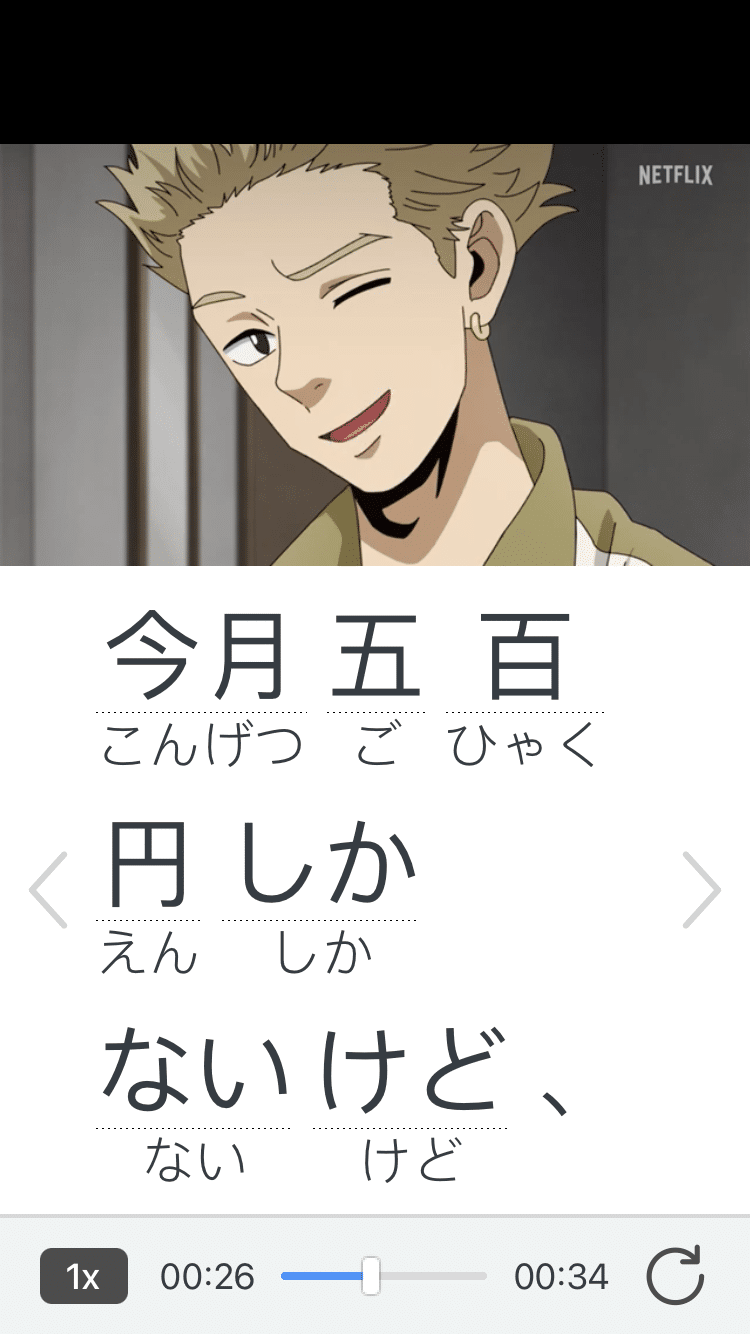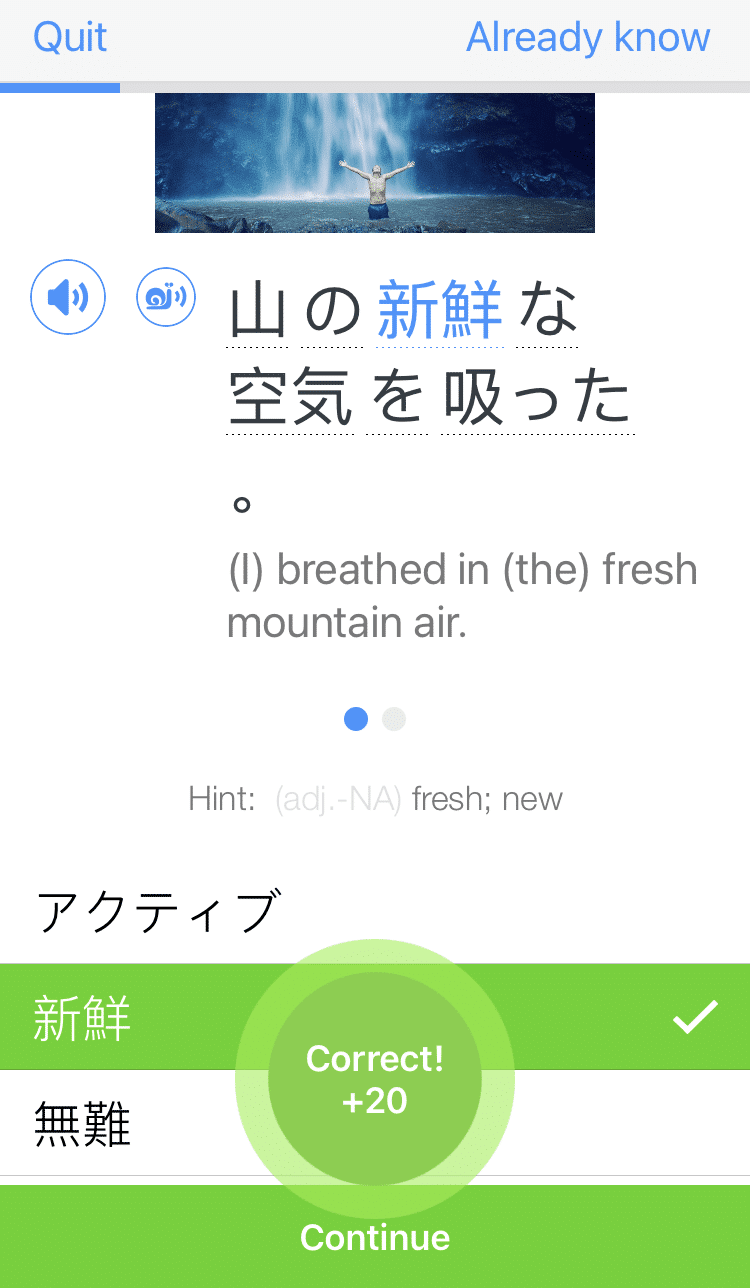200+ Katakana Words: Your Introduction to Japanese Loanwords

In a nutshell, katakana uses characters to represent syllables (instead of single letters like an alphabet) and it’s used primarily for re-imagining foreign words in the Japanese language.
Below, I’ve put together a guide on everything you need to know about katakana.
Download: This blog post is available as a convenient and portable PDF that you can take anywhere. Click here to get a copy. (Download)
What Is Katakana?
As I’ve mentioned, 片仮名 (かたかな) — katakana is a Japanese writing system used to transcribe foreign words, sound effects, titles and loan words into Japanese words.
Think of it this way: To read Japanese words, you might have used ローマ字 (ろーまじ) — rōmaji, or Latin-based script that shows you how to sound out each syllable with letters familiar to you. (“Rōmaji” is an example of rōmaji!)
Japanese speakers use the same concept with foreign words. Just as English speakers use rōmaji, Japanese speakers use katakana.
Katakana is syllable-based, meaning each character in its “alphabet” represents a particular syllable or sound. Those syllables are put together to sound out foreign words in a way Japanese speakers can pronounce and understand.
Katakana is mainly used for writing loanwords or 外来語 (がいらい ご) — gairaigo, words from other languages that become part of the Japanese language. (This happens in English, too: for example, “karaoke” is a Japanese loanword that’s now part of the English vocabulary.)
So why bother learning katakana if it’s just a bunch of foreign (often English) words rewritten for Japanese readers?
Well, katakana is just as important as 漢字 (かんじ) — kanji and 平仮名 (ひらがな) — hiragana. It’s used frequently, especially with Western concepts, modern technologies and internet communication.
Therefore, if you want to really take your fluency to the next level, you’ll need to get a grasp on katakana syllables and common words.
Meet the Syllabary: List of Katakana Characters
There are 46 katakana characters, some of which can be combined to form even more sounds.
Below is a basic katakana chart with hiragana and rōmaji pronunciations.
To figure out how to read each word, check what row of vowels and what column of consonants they fall under. For example, since カ is under the consonant “k” and on the row “a,” it’s pronounced ka.
Note that Japanese syllabary tables (and Japanese texts in general) are traditionally designed to be read from right to left. However, I’ve arranged the table below from left to right since that’s how English speakers normally read a text. You can get comfortable with reading from right to left as you advance in your Japanese studies.
| k | s | t | n | h | m | l/r**** | w | y | n/m***** | ||
|---|---|---|---|---|---|---|---|---|---|---|---|
| a | ア (あ) | カ (か) | サ (さ) | タ (た) | ナ (な) | ハ (は) | マ (ま) | ラ (ら) | ワ (わ) | ヤ (や) | |
| i | イ (い) | キ (き) | シ (し) - shi | チ (ち) chi* | ニ (に) | ヒ (ひ) | ミ (み) | リ (り) | |||
| u | ウ (う) | ク (く) | ス (す) | ツ (つ) tsu** | ヌ (ぬ) | フ (ふ) fu*** | ム (む) | ル (る) | ユ (ゆ) | ||
| e | エ (え) | ケ (け) | セ (せ) | テ (て) | ネ (ね) | ヘ (へ) | メ (め) | レ (れ) | |||
| o | オ (お) | コ (こ) | ソ (そ) | ト (と) | ノ (の) | ホ (ほ) | モ (も) | ロ (ろ) | ヲ (を) | ヨ (よ) | |
| ン (ん) |
*Chi can be used with the “ti” sound, such as in “team” or chimu ( チーム or ちーむ), or the “chi” sound, as in “chicken” or chikin ( チキン or ちきん).
**Tsu can be used for any syllable with the “tu” sound, like “tool” or tsūru ( ツール or つーる).
***Fu is the only f sound in Japanese and can be interchanged with hu. Syllables like fa, fi or fo don’t exist, so when you need to make a word like “family” with katakana, you need to use additional vowel characters: ファミリー (Family) becomes, essentially, fu-ah-mi-ri, for instance.
****Japanese doesn’t have an “l” sound, so it uses “r” for loanwords that have the “l” sound in the original language. For example, “really” would be riarii ( リアリー or りありー).
*****ン (ん) is the only character used at the end of a syllable rather than the beginning.
Here are a few more katakana syllables, which are essentially derivatives of some of the characters shown above. Like in hiragana, adding diacritics to certain characters changes their pronunciation. The diacritics are called dakuten (゛) and handakuten (゜ ).
To illustrate, the “k” sound would become “g,” the “s” would become “z” and so on when diacritics are added. Some syllables use both dakuten and handakuten: for example, ハ (は or ha) can become バ (ば or ba) or パ (ぱ or pa).
| g | z | d | b | p | |
|---|---|---|---|---|---|
| a | ガ (が) | ザ (ざ) | ダ (だ) | バ (ば) | パ (ぱ) |
| i | ギ (ぎ) | ジ (じ) | ヂ (ぢ) | ビ (び) | ピ (ぴ) |
| u | グ (ぐ) | ズ (ず) | ヅ (づ) | ブ (ぶ) | プ (ぷ) |
| e | ゲ (げ) | ゼ (ぜ) | デ (で) | ベ (べ) | ペ (ぺ) |
| o | ゴ (ご) | ゾ (ぞ) | ド (ど) | ボ (ぼ) | ポ (ぽ) |
Forming Katakana Words
There are many ways to form katakana words. You can:
- Add a small yu, ya or yo to a katakana syllable that represents a consonant. For example, ketchup becomes ケチャップ (けちゃっぷ) or ke-cha-ppu. Remember to write the “y” sound in a smaller case; otherwise, the pronunciation would be “chi-ya” instead of “cha.”
- Add vowels to a katakana syllable that represents a consonant. The katakana for “Disney” is a good example of this. It would be ディズニー or dizuni (でぃずにー) where the デ (de) and イ (i) sounds are combined to make “di.” As with the previous point, make sure the vowel sound is in a smaller case. Otherwise, ディ (di or ぢ) would become デイ (dei or でい).
- Use an elongation mark to indicate long vowel sounds. For example, the katakana for “taxi” is タクシ ー (たくしー) or takushi where you pronounce the last syllable a bit longer.
- Use a smaller case ツ (tsu) to indicate double consonant sounds that pause or emphasize the preceding consonant. For example, you write ハッピー (happī or はっぴー) for “happy.”
Although you can create your own katakana words if you can’t think of the Japanese word for something, there are many established words you can learn.
200+ Katakana Words to Jump-start Your Vocabulary
I’ve grouped the words below thematically to make them easier to learn—but also to give you a better sense of the kinds of words that often use katakana.
Places
スーパーマーケット
すーぱー まーけっと (sūpāmāketto)
supermarket
コンビニ
こんびに (konbini)
convenience store
レストラン
れすとらん (resutoran)
restaurant
ホテル
ほてる (hoteru)
hotel
マンション
まんしょん (manshon)
condominium
アパート
あぱーと (apāto)
apartment
ビーチ
びーち (bīchi)
beach
パーク
ぱーく (pāku)
park
ショッピングモール
しょっぴんぐもーる (shoppingumōru)
shopping mall
スタジアム
すたじあむ (sutajiamu)
stadium
シネマ
しねま (shinema)
cinema
ギャラリー
ぎゃらりー (gyararī)
gallery
ミュージアム
みゅーじあむ (myūjiamu)
museum
テーマパーク
てーまぱーく (tēma pāku)
theme park
ビューティーサロン
びゅーてぃーさろん (byūtī saron)
beauty salon
カフェ
かふぇ (kafe)
cafe
ギフトショップ
ぎふとしょっぷ (gifuto shoppu)
gift shop
ジム
じむ (jimu)
gym
カラオケボックス
からおけぼっくす (karaoke bokkusu)
karaoke box
Note: “Karaoke” is written in katakana because it actually isn’t an entirely Japanese word, but rather a combination of 空 ( から
) — empty and the loanword オーケストラ
(おーけすとら) — orchestra.
ライブハウス
らいぶはうす (raibu hausu)
live house
カジノ
かじの (kajino)
casino
クラブ
くらぶ (kurabu)
club
カルチャーセンター
かるちゃーせんたー (karuchāsentaー)
cultural center
ギャンブル場
ぎゃんぶるば (gyanburu ba)
gambling venue
スパ
すぱ (supa)
spa
プール
ぷーる (pūru)
pool
サウナ
さうな (sauna)
sauna
プラザ
ぷらざ (puraza)
plaza
Geographical Locations
ヨーロッパ
よーろっぱ (yōroppa)
Europe
アメリカ
あめりか (amerika)
America
イタリア
いたりあ (itaria)
Italy
オランダ
おらんだ (oranda)
Holland
カナダ
かなだ (kanada)
Canada
スペイン
すぺいん (supein)
Spain
フランス
ふらんす (furansu)
France
ロシア
ろしあ (roshia)
Russia
アフリカ
あふりか (afurika)
Africa
アジア
あじあ (ajia)
Asia
オーストラリア
おーすとらりあ (ōsutoraria)
Australia
サハラ
さはら (sahara)
Sahara Desert
カリブ
かりぶ (karibu)
Caribbean
コンゴ
こんご (kongo)
Congo
アンデス
あんです (andesu)
Andes
ニュージーランド
にゅーじーらんど (nyūjīrando)
New Zealand
モンゴル
もんごる (mongoru)
Mongolia
モロッコ
もろっこ (morokko)
Morocco
カンボジア
かんぼじあ (kanbojia)
Cambodia
マダガスカル
まだがすかる (madagasukaru)
Madagascar
ベトナム
べとなむ (betonamu)
Vietnam
ケニア
けにあ (kenia)
Kenya
アルゼンチン
あるぜんちん (aruzenchin)
Argentina
タンザニア
たんざにあ (tanzania)
Tanzania
ブラジル
ぶらじる (burajiru)
Brazil
ウルグアイ
うるぐあい (uruguai)
Uruguay
Holidays
クリスマス
くりすます (kurisumasu)
Christmas
ハロウィン
はろうぃん (harowin)
Halloween
バースデー
ばーすでー (bāsudē)
birthday
イースター
いーすたー (īsutā)
Easter
サンクスギビングデー
さんくすぎびんぐでー (sankusugibingudē)
Thanksgiving Day
アースデー
あーすでー (āsudē)
Earth Day
バレンタイン
ばれんたいん (barentain)
Valentine’s Day
ゴールデンウィーク
ごーるでんうぃーく (gōruden wīku)
Golden Week (a series of holidays in late April and early May in Japan)
シルバーウィーク
しるばーうぃーく (shirubā wīku)
Silver Week (a series of holidays in September in Japan)
ホワイトデー
ほわいとでー (howaito dē)
White Day (a day when men give gifts to women in return for Valentine’s Day)
Food
ハンバーガー
はんばーがー (hanbāgā)
hamburger
チョコレート
ちょこれーと (chokorēto)
chocolate
ピザ
ぴざ (piza)
pizza
カレー
かれー (karē)
curry
アイスクリーム
あいすくりーむ (aisukurīmu)
ice cream
フライドポテト
ふらいど ぽてと (furaidopoteto)
French fries
ケーキ
けーき (kēki)
cake
サンドイッチ
さんどいっち (sandoitchi)
sandwich
スパゲッティ
すぱげってぃ (supagetti)
spaghetti
チーズ
ちーず (chīzu)
cheese
ラーメン
らーめん (rāmen)
ramen
カツ丼
かつどん (katsudon)
katsudon (breaded and deep-fried pork cutlet served over rice)
オムライス
おむらいす (omuraisu)
omurice (omelette served over rice)
カルビ
かるび (karubi)
kalbi (Korean-style marinated beef short ribs)
タコス
たこす (takosu)
tacos
サラダ
さらだ (sarada)
salad
テンプラ
てんぷら (tenpura)
tempura (battered and deep-fried seafood or vegetables)
シーフード
しーふーど (shīfūdo)
seafood
カニ
かに (kani)
crab
エビ
えび (ebi)
shrimp
カツオ
かつお (katsuo)
bonito (type of fish)
ユッケ
ゆっけ (yukke)
yukhoe (Korean dish made with raw beef)
ウナギ
うなぎ (unagi)
eel
ホタテ
ほたて (hotate)
scallop
イクラ
いくら (ikura)
salmon roe
トマト
とまと (tomato)
tomato
メロン
めろん (meron)
melon
コーヒー
こーひー (kōhī)
coffee
ジュース
じゅーす (jūsu)
juice
ビール
びーる (bīru)
beer
ダイエット
だいえっと (daietto)
diet
Sports
アメリカンフットボール / アメフト
あめりかんふっとぼーる / あめふと (amerikan futtobōru / amefuto)
American football
バスケットボール / バスケ
ばすけっとぼーる / ばすけ (basukettobōru / basuke)
basketball
チアリーダー
ちありーだー (chiarīdā)
cheerleader
サッカー
さっかー (sakkā)
soccer
ゴルフ
ごるふ (gorufu)
golf
ラグビー
らぐびー (ragubī)
rugby
テニス
てにす (tenisu)
tennis
バドミントン
ばどみんとん (badominton)
badminton
ソフトボール
そふとぼーる (sofutobōru)
softball
ボクシング
ぼくしんぐ (bokushingu)
boxing
カヌー
かぬー (kanū)
canoe
アーチェリー
あーちぇりー (ācherī)
archery
スイミング
すいみんぐ (suimingu)
swimming
サーフィン
さーふぃん (sāfin)
surfing
スケートボード
すけーとぼーど (skētobōdo)
skateboarding
ボルダリング
ぼるだりんぐ (borudaringu)
bouldering
スキー
すきー (sukī)
skiing
スノーボード
すのーぼーど (sunōbōdo)
snowboarding
フィギュアスケート
ふぃぎゅあすけーと (figyua sukēto)
figure skating
バレーボール
ばれーぼーる (barēbōru)
volleyball
ボウリング
ぼうりんぐ (bōringu)
bowling
アーティスティックスイミング
あーてぃすてぃっくすいみんぐ (ātisutikkusuimingu)
artistic swimming
スポーツカー
すぽーつかー (supōtsukā)
sports car
Technology
マスコミ
ますこみ (masukomi)
mass media or mass communications
カメラ
かめら (kamera)
camera
テレビ
てれび (terebi)
television
アニメ
あにめ (anime)
animation
Note: Outside of Japan the word “anime” is used for a particular form of Japanese animation, but in Japan the word is used to describe all forms of animation.
エスカレーター
えすかれーたー (esukarētā)
escalator
バイク
ばいく (baiku)
motorbike
アイテム
あいてむ (aitemu)
item (especially in a video game)
ミッション
みっしょん (misshon)
mission (especially in a videogame)
コンピューター
こんぴゅーたー (konpyūtā)
computer
スマートフォン
すまーとふぉん (sumātofon)
smartphone
インターネット
いんたーねっと (intānetto)
internet
デジタル
でじたる (dejitaru)
digital
ロボット
ろぼっと (robotto)
robot
ソフトウェア
そふとうぇあ (sofutowea)
software
ハードウェア
はーどうぇあ (hādouea)
hardware
インターフェース
いんたーふぇーす (intāfēsu)
interface
ガジェット
がじぇっと (gajetto)
gadget
バイオテクノロジー
ばいおてくのろじー (baiotekunorojī)
biotechnology
クラウド
くらうど (kuraudo)
cloud
センサー
せんさー (sensā)
sensor
ロケーション
ろけーしょん (rokēshon)
location
アルゴリズム
あるごりずむ (arugorizumu)
algorithm
ネットワーク
ねっとわーく (nettowāku)
network
データ
でーた (dēta)
data
プログラミング
ぷろぐらみんぐ (puroguramingu)
programming
ロボティクス
ろぼてぃくす (robotikusu)
robotics
バイオメトリクス
ばいおめとりくす (baiometorikusu)
biometrics
アプリ
あぷり (apuri)
app
リモコン
りもこん (rimokon)
remote control
モード
もーど (mōdo)
mode
People and Names
モーツァルト
もーつぁると (mōtsuaruto)
Mozart
ドナルド・トランプ
どなるど・とらんぷ (donarudo toranpu)
Donald Trump
バラク・オバマ
ばらく・おばま (baraku obama)
Barack Obama
ブリトニー・スピアーズ
ぶりとにー・すぴあーず (buritonī supiāzu)
Britney Spears
オプラ
おぷら (opura)
Oprah
エルビス・プレスリ
えるびす・ぷれすりー (erubuisu puresurī)
Elvis Presley
キム・カーダシアン
きむ・かーだしあん (kimu kādashian)
Kim Kardashian
ビヨンセ
びよんせ (biyonse)
Beyoncé
ブラッド・ピット
ぶらっど・ぴっと (buraddo pitto)
Brad Pitt
オードリー・ヘップバーン
おーどりー・へっぷばーん (ōdorī heppubān)
Audrey Hepburn
マリリン・モンロー
まりりん・もんろー (maririn monrō)
Marilyn Monroe
ウィル・スミス
うぃる・すみす (wiru sumisu)
Will Smith
アルフレッド・ヒッチコック
あるふれっど・ひっちこっく (arufureddo hitchikokku)
Alfred Hitchcock
マイケル・ジャクソン
まいける・じゃくそん (maikeru jakuson)
Michael Jackson
リアーナ
りあーな (riāna)
Rihanna
ジャスティン・ビーバー
じゃすてぃん・びーばー (jasutin bībā)
Justin Bieber
レディー・ガガ
れでぃー・がが (redī gaga)
Lady Gaga
アンジェリーナ・ジョリー
あんじぇりーな・じょりー (anjīrīna jorī)
Angelina Jolie
ブルース・リー
ぶるーす・りー (burūsu rī)
Bruce Lee
デヴィッド・ボウイ
でヴぃっど・ぼうい (devuiddo boui)
David Bowie
ジョニー・デップ
じょにー・でっぷ (jonī deppu)
Johnny Depp
カミラ・カベロ
かみら・かべろ (kamira kabero)
Camila Cabello
ブルノ・マーズ
ぶるの・まーず (buruno māzu)
Bruno Mars
ジョージ・クルーニー
じょーじ・くるーにー (jōji kurūnī)
George Clooney
Other Words
アイドル
あいどる (aidoru)
idol or pop star
ヒットソング
ひっとそんぐ (hitto songu)
hit song
フリーター
ふりーたー (furītā)
part-timer or freeter
メーク
めーく (mēku)
makeup/cosmetics
ツアー
つあー (tsuā)
tour
サラリーマン
さらりーまん (sararīman)
salaryman
ビジネスマン
びじねすまん (bijinesuman)
businessman
Note: “Businessman” is sometimes used interchangeably with “salaryman,” although “businessman” has a broader scope than “male white-collar employee”
オフィスレディ
おふぃすれでぃ (ofisu redi)
office lady
Note: “Office lady” is often abbreviated to “OL” ( オーエル
or おーえる (ōeru))
ソファ
そふぁ (sofa)
sofa
アフターサービス
あふたーさーびす (afutā sābisu)
after service a.k.a. customer service or after-the-sale service
アンサー
あんさー (ansā)
answer
アルコール
あるこーる (arukōru)
alcohol
フリーサイズ
ふりーさいず (furī saizu)
free size, a.k.a. “one size fits all”
ドキュメント
どきゅめんと (dokyumento)
document
アドバイス
あどばいす (adobaisu)
advice
トラブル
とらぶる (toraburu)
trouble
シナリオ
しなりお (shinario)
scenario
メモ
めも (memo)
memo
タイム
たいむ (taimu)
time
ボリューム
ぼりゅーむ (boryūmu)
volume
テーマ
てーま (tēma)
theme
パートナー
ぱーとなー (pātonā)
partner
スタイル
すたいる (sutairu)
style
クリア
くりあ (kuria)
clear
ファッション
ふぁっしょん (fasshon)
fashion
ミュージック
みゅーじっく (myūjikku)
music
ノート
のーと (nōto)
notebook
ダンス
だんす (dansu)
dance
グラス
ぐらす (gurasu)
glass
Note: グラス is also the katakana for “grass.” Sometimes in Japanese, context is everything!
ボーナス
ぼーなす (bōnasu)
bonus
Important Things to Note About Katakana
So, when do you use the katakana version of a word?
- Stand-ins for words that don’t exist in Japanese: For example, since there’s no word for “supermarket” in Japanese, katakana must be used. In the same vein, there are also Japanese words that don’t exist in other languages.
- Context: Perhaps you’re speaking to a beginner Japanese learner and katakana is a little easier for them to understand. Maybe other speakers in a group conversation are using a lot of katakana. There’s no right or wrong: just go with the flow!
It’s also worth noting that some katakana words are shortened, like スーパーマーケット (すーぱー まーけっと) — sūpāmāketto (supermarket), which is often shortened to スーパー (すーぱー) — sūpā. Japanese has its own slang just like English does.
Finally, keep in mind that some loan words come from languages other than English, while other words have odd origins. For instance, the word バイキング (ばいきんぐ) — Baikingu might sound like “Viking” or “biking,” but it actually means “buffet-style” in Japanese. Likewise, ドイツ (どいつ) — Germany is pronounced Doitsu to reflect the German word for the country, Deutschland.
There are actually quite a lot of weird katakana words like this with very interesting and somewhat comical origins. So, just remember: Things aren’t always what they look like:
6 Japanese Words Everyone Thinks They Understand (But Don’t)
1. テンション (tenshon)
At first glance, this looks like it may mean “tension” or “tense,” as in “the tension in the 職員室 (shokuinshitsu, teacher’s staff room) was palpable after Takashi admitted he was the one who had peed in the coffee machine.”
However, in Japanese テンション takes on quite the opposite meaning, typically seen in the phrase テンションが高い!(tenshon ga takai!). This means that “he/she is really excited” or “in high spirits.” This phrase is synonymous with 盛り上がっている (moriagatteiru) “to be pumped/charged up.”
There are a few theories behind how it came to take on this positive nuance, the most plausible of which comes from the music world.
In constructing musical chords, jazz musicians will frequently employ “tension notes” to add character and depth to a certain chord. Japanese musicians would speak to each other saying “テンションをあげよう!” (tenshon oh ageyou!) or “let’s add more tension (notes).” Fans would interpret this to mean 盛り上げよう!(moriageyou) or “let’s really get things pumping!”
Example:
たかしはテンションが高いね!入学試験(nyuugakushiken)を合格(goukaku)したかな?
Takashi is really excited! I wonder if he passed his college entrance exams.
2. スナック (snakku)
A スナック in Japanese is not a delicious treat one may eat in the afternoon to tide over their hunger until dinner. That type of snack would be 軽食 (keishoku). No, a スナック in Japanese is a shortening of the word スナックバー (snakkubaa), which is a type of hostess bar which serves alcohol and small appetizers and employs younger girls to talk to and flirt with their all-male customer base.
Typically these establishments charge a rather high hourly fee for the service of just chatting with the younger girls, but snakku bars usually don’t offer “extra-curricular” (sexual) services. These services are more common at places called キャバクラ (kyabakura).
Example:
After a drinking party…
A: 何か、飲み足りない(nomitarinai)なぁ。キャバクラでも行かない?
B: いやぁ、行き着きのスナックに寄りたい。一緒に来ない?
A: I feel like drinking some more. Want to go to a kyabakura?
B: Nah, I’d like to drop by the snakku I usually go to. Want to come with?
3. カンニング (kanningu)
Think back to high school. Were you ever guilty of taking a peek over at your neighbor’s answer sheet? If so, カンニングした!
カンニング comes from the English word “cunning,” and it isn’t too far off from its English origin. However, keep in mind that it’s a noun and only means “cheating.” It cannot be used as an adjective. To say “cunning” as an adjective, you can use the popular word ずるい (zurui) or the less often heard but still valid word 狡猾 (koukatsu).
カンニング is said to have entered Japanese during the early Meiji Era among students who were looking to pull fast ones on their professors. Rather than outright discuss cheating, they would refer to cheating as カンニング as a secret word, to mask what they were actually discussing.
Example:
A: のぶは数学(suugaku)の試験(shiken)を受かったのか?!あのバカはいったいどうやってできた?!
B: あの天才(tennsai)のみちこの回答用紙(kaitouyoushi)を覗き見(nozokimi)して、カンニングしたらしい。
A: Nobu passed the Math exam?! How in the world did that idiot do it?!
B: I heard he cheated, peeking at that genius Michiko’s answer sheet.
4. アメリカン・ジョーク (amerikan jooku)
Who can’t go for a good old American joke every once in a while? The Japanese, that’s who. This is because in Japanese, an アメリカン・ジョーク is not a “joke made by and American” or a “joke about Americans,” rather, it’s a joke that just plain old sucks (to the Japanese at least).
Humor is probably the most difficult aspect of a language to translate into another language. The origins of アメリカン・ジョーク can be found in the fact that a specific subset of jokes told in America (and other countries too, to be fair) require the listener to connect the dots and figure out for themselves why something is funny.
Listeners have to “intuit” their way through how seemingly unrelated pieces of information can be put together in a funny way. Unfortunately, the Japanese just don’t tell jokes this way, and thus, when translating this type of humor into Japanese, the punch line is often lost on listeners.
Take this exchange between A and B as A tells a joke to B (keep in mind, this is NOT a Japanese joke. Don’t try to use it yourself unless you are ready to face a room full of cold stares).
Example:
A: 2頭(tou)のクジラはバーで飲んでいる。1頭はもう1頭に向かってこう言う(Aはクジラの鳴き声(nakigoe)を2分ほどマネをする)。そして、そのもう1頭は最初(saisho)のクジラに向けて答えた。「お前、酔ってる(yotteru)ね」
B: (笑わずに真剣(shinnken)な顔をしている)わかんないよ。アメリカン・ジョークだね。
A: Two whales are drinking in a bar. One whale says to the other… (speaker A imitates a whale song for 2 minutes). Then, the other whale looks at the first and answers “Dude, I think you’re drunk.”
B: (not-laughing and with a serious expression). I don’t get it. That’s such an American joke.
*Note: アメリカン・ジョーク are not strictly limited to being told by Americans. There are plenty of British, Australian and people of all nationalities who, to their chagrin, have been lumped in with their American counterparts as purveyors of アメリカン・ジョークs.
5. マイペース (maipeesu)
マイペース most likely entered Japanese through the world of marathon running. A runner might say, “私はいつもマイペースで走っています” (watashi wa itsumo maipeesu de hashitte imasu) meaning “I always run at my (own) pace.”
Runners who run at “マイペース” try not to get drawn by other runners into running too hard and too fast, tiring themselves out before the end of the race.
However, this original meaning of マイペース was later generalized to mean someone who “lives life at their own pace.” Someone who is マイペース generally won’t be rushed to do things, or has a tendency to “do things their own way.”
Example:
A: この仕事をなみちゃんい任せよう(makaseyou)と思っていますが、いかがでしょうか?
B: いや、なみはすごくマイペースで、これはしっかりした形でしないなりません。
A: I was thinking of leaving this work to Nami, what do you think?
B: Nah, Nami has her own way of doing things, and this needs to be done according to standard.
6. マイ… (mai…)
マイ is a particularly odd duck of a word. Possibly having originated as an expansion from the previous example マイペース, マイ is used as a prefix to describe something as “one’s own,” can be attached to almost anything that one owns.
Thus マイカー、マイハウス、マイ犬 respectively mean “my car,” “my house,” and “my dog.” A popular usage of this is マイ箸(maihashi), or “my chopsticks,” specifically used for chopsticks that one carries around with them so they don’t have to waste lots of 割り箸 (waribashi) or wooden, disposable chopsticks.
However, the use of マイ is often a source of confusion for Japanese learners, as it does not specifically mean “my,” but rather means “one’s own.” Take a look at the following example:
Example:
A: マイボールペン持っていますか?
B: いやぁ、忘れちゃったな。あなたのマイボールペンを借りてもいいですか?
A: Do you have your own pen?
B: Ahh, it looks like I forgot it. Could I borrow yours?
When speaker A asks speaker B if he has マイボールペン, he is not asking if speaker B has speaker A’s pen (as one might assume by the prefix マイ), but rather, is asking if speaker B has his own pen. Thus, to clarify, speaker B may want to ask speaker A if A has “あなたのマイボールペン,” or, in English, if A has a pen that belongs to A.
Another great example comes from the sports world. Playing basketball or soccer, when the ball goes out of bounds players will often frenzy, screaming “it’s our ball!” to claim who should get possession. Possession of the ball in this instance in Japanese is called マイボール.
Example:
(a basketball is knocked out of bounds during a game between two people)
A: よし、マイボールだ。
B: 違うでしょう!お前は最後に触った(sawatta)だろう!私のマイボールだぞ!
A: 分かった、分かった。触ってないと思うけど、今回はお前のマイボールとして許す(yurusu)。でも今度は私のマイボールになる。
A: Alright, it’s my ball.
B: No way! You touched it last! It’s my ball!
A: Okay, okay. I don’t think I touched it, but I’ll let you take it this time. But next time it’ll be my ball.
Using and interpreting マイ correctly may be confusing at first, but just remember that when people say “マイ” they could be referring to something that is theirs, or asking you about something that is yours.
Isn’t katakana such an interesting syllabary?
If you want to learn more Japanese words, check out these posts on the ones that are cute, useful and food-related.
You can also hop on a language learning platform like FluentU, which showcases immersive videos complete with interactive subtitles.
FluentU takes authentic videos—like music videos, movie trailers, news and inspiring talks—and turns them into personalized language learning lessons.
You can try FluentU for free for 2 weeks. Check out the website or download the iOS app or Android app.
P.S. Click here to take advantage of our current sale! (Expires at the end of this month.)

Good luck! Or rather, グッドラック ! (ぐっどらっく) — Guddo rakku!
Download: This blog post is available as a convenient and portable PDF that you can take anywhere. Click here to get a copy. (Download)
And One More Thing...
If you love learning Japanese with authentic materials, then I should also tell you more about FluentU.
FluentU naturally and gradually eases you into learning Japanese language and culture. You'll learn real Japanese as it's spoken in real life.
FluentU has a broad range of contemporary videos as you'll see below:

FluentU makes these native Japanese videos approachable through interactive transcripts. Tap on any word to look it up instantly.

All definitions have multiple examples, and they're written for Japanese learners like you. Tap to add words you'd like to review to a vocab list.

And FluentU has a learn mode which turns every video into a language learning lesson. You can always swipe left or right to see more examples.

The best part? FluentU keeps track of your vocabulary, and gives you extra practice with difficult words. It'll even remind you when it’s time to review what you’ve learned. You'll have a 100% personalized experience.
Start using the FluentU website on your computer or tablet or, better yet, download the FluentU app from the iTunes or Google Play store. Click here to take advantage of our current sale! (Expires at the end of this month.)







